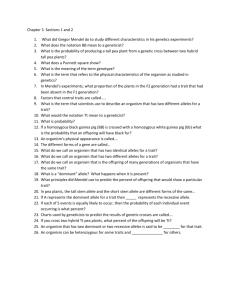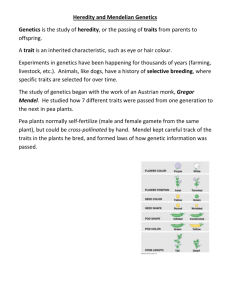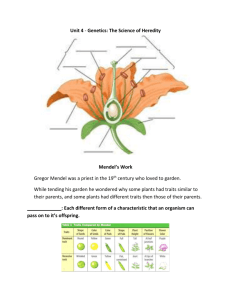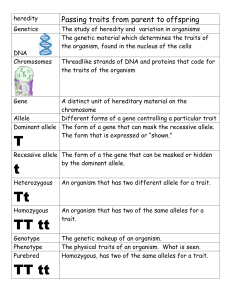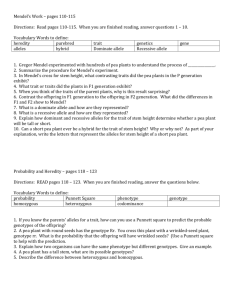Mendel`s Genetics
advertisement
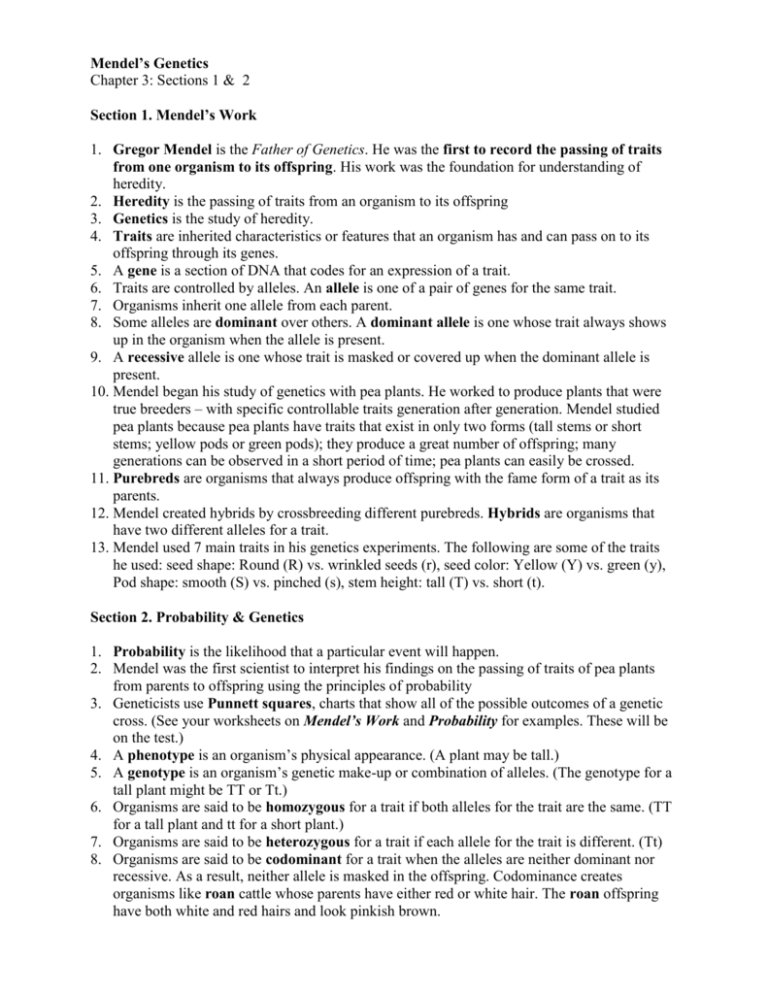
Mendel’s Genetics Chapter 3: Sections 1 & 2 Section 1. Mendel’s Work 1. Gregor Mendel is the Father of Genetics. He was the first to record the passing of traits from one organism to its offspring. His work was the foundation for understanding of heredity. 2. Heredity is the passing of traits from an organism to its offspring 3. Genetics is the study of heredity. 4. Traits are inherited characteristics or features that an organism has and can pass on to its offspring through its genes. 5. A gene is a section of DNA that codes for an expression of a trait. 6. Traits are controlled by alleles. An allele is one of a pair of genes for the same trait. 7. Organisms inherit one allele from each parent. 8. Some alleles are dominant over others. A dominant allele is one whose trait always shows up in the organism when the allele is present. 9. A recessive allele is one whose trait is masked or covered up when the dominant allele is present. 10. Mendel began his study of genetics with pea plants. He worked to produce plants that were true breeders – with specific controllable traits generation after generation. Mendel studied pea plants because pea plants have traits that exist in only two forms (tall stems or short stems; yellow pods or green pods); they produce a great number of offspring; many generations can be observed in a short period of time; pea plants can easily be crossed. 11. Purebreds are organisms that always produce offspring with the fame form of a trait as its parents. 12. Mendel created hybrids by crossbreeding different purebreds. Hybrids are organisms that have two different alleles for a trait. 13. Mendel used 7 main traits in his genetics experiments. The following are some of the traits he used: seed shape: Round (R) vs. wrinkled seeds (r), seed color: Yellow (Y) vs. green (y), Pod shape: smooth (S) vs. pinched (s), stem height: tall (T) vs. short (t). Section 2. Probability & Genetics 1. Probability is the likelihood that a particular event will happen. 2. Mendel was the first scientist to interpret his findings on the passing of traits of pea plants from parents to offspring using the principles of probability 3. Geneticists use Punnett squares, charts that show all of the possible outcomes of a genetic cross. (See your worksheets on Mendel’s Work and Probability for examples. These will be on the test.) 4. A phenotype is an organism’s physical appearance. (A plant may be tall.) 5. A genotype is an organism’s genetic make-up or combination of alleles. (The genotype for a tall plant might be TT or Tt.) 6. Organisms are said to be homozygous for a trait if both alleles for the trait are the same. (TT for a tall plant and tt for a short plant.) 7. Organisms are said to be heterozygous for a trait if each allele for the trait is different. (Tt) 8. Organisms are said to be codominant for a trait when the alleles are neither dominant nor recessive. As a result, neither allele is masked in the offspring. Codominance creates organisms like roan cattle whose parents have either red or white hair. The roan offspring have both white and red hairs and look pinkish brown.


